 Japan (1987)
Japan (1987)
Self-Propelled Anti-Aircraft Gun – 52 Built
With a view to replacing the M42 Duster, the Japanese Ground Self Defense Force (JGSDF) took interest in the German Flakpanzer Gepard.
Heavily influenced by this vehicle, Mitsubishi Heavy Industries designed the Type 87 Self-Propelled Anti-Aircraft Gun (87式自走高射機関砲 hati-nana-shiki-jisou-kousya-kikan-hou).
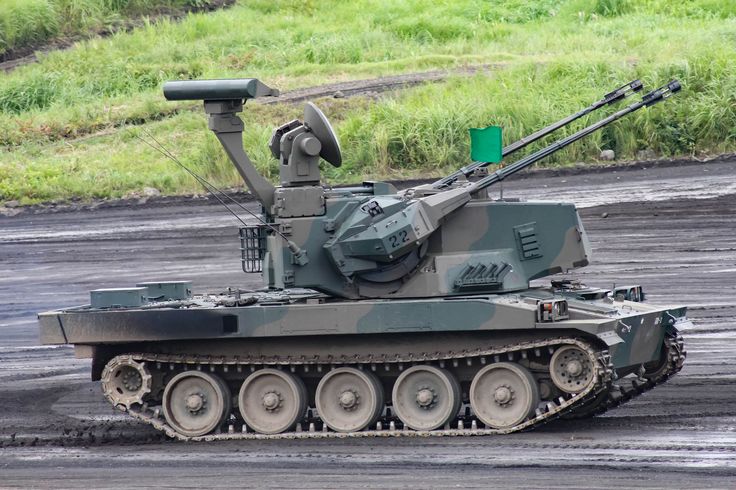
The Japanese Gepard
By the 1970’s the American built M42 Dusters which were in service with the JGSDF were starting to show their age. The Japanese Ministry of Defense realized that a new anti-aircraft gun system was required for any battle that may come in the 21st century. So the development of the Type 87 began.
Originally, the new vehicle was to be based on the Type 61. The weapon of choice was to be the American supplied M51 Skysweaper 75mm Auto-Loading AA gun. A prototype of the vehicle mounting this gun was debuted in 1972. It was put through trials and was not well received. The weapon being deemed to be unreliable, and vastly out of date. In 1978, a second attempt was made with a weapons system supplied by the venerable Oerlikon company. This vehicle was named the AWX. Though the new turret and weapon system were deemed successful, the overall weight of the combined systems on the Type 61 chassis greatly reduced the desired mobility ratios.
As such, the Type 61 chassis was rejected. In 1982 the chassis of the Type 74 Main Battle Tank was chosen to mount the weapon system. In order to keep the same maintenance procedures, the Type 74’s hydropneumatic suspension was kept on the chassis.

Weaponry
The influence of the Flakpanzer Gepard is most noticeable in the Type 87’s weapon system. The main armament consists of two 35 mm Oerlikon cannons. These cannons are built under license by Japan Steel Works.
These cannons fire 35x288mm shells at 550 rounds per minute, per barrel, with a wealth of different ammunition types at its disposal. These include Armor Piercing, Incendiary and Explosive rounds.
The cannons, like those on the Gepard, are mounted either side of the turret, with the ability to elevate 92 degrees, and depress 5 degrees at a rate of 760 millimeters a second. The turret, of course, has a full 360-degree rotation, with full traverse achieved at a rate of 1,000 millimeters a second. The barrels are tipped with a projectile velocity sensor. Smoke grenade launchers are mounted on the turret to help mask the vehicle’s position if necessary.
Sensory Equipment
Like the Gepard, the Type 87 uses radar assisted target acquisition. It’s main computing systems were developed by Mitsubishi’s Electric Corporation. The main sensory arrays are mounted on the turret. The main radar dish is mounted on the top rear, instead of the front as with the leopard. This is because the Gepards sensory system layout was patented at the time.

The tracking radar is gyroscopically stabilized, meaning it always stays facing whichever target it is locked on, regardless of where the turret is pointing. It has a reported range of 20 Kilometers. The secondary searching radar is mounted behind the main dish on an arm and continuously spins when in operation. This arm is in the up position during in combat operations but can be lowered for transportation. The main computing hub for these systems are housed in the box-like nose of the turret.
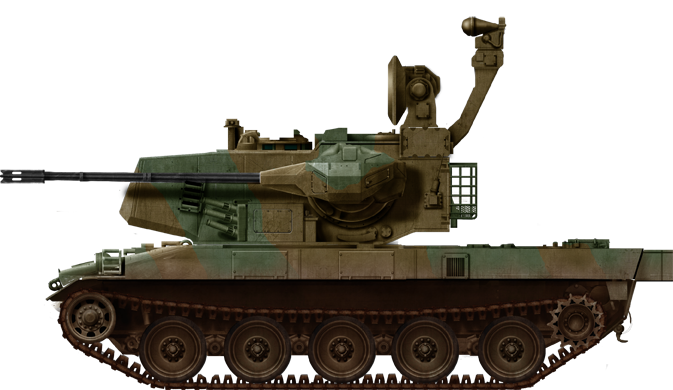
Tanks Encyclopedia’s own illustration of the Type 87 SPAAG by David Bocquelet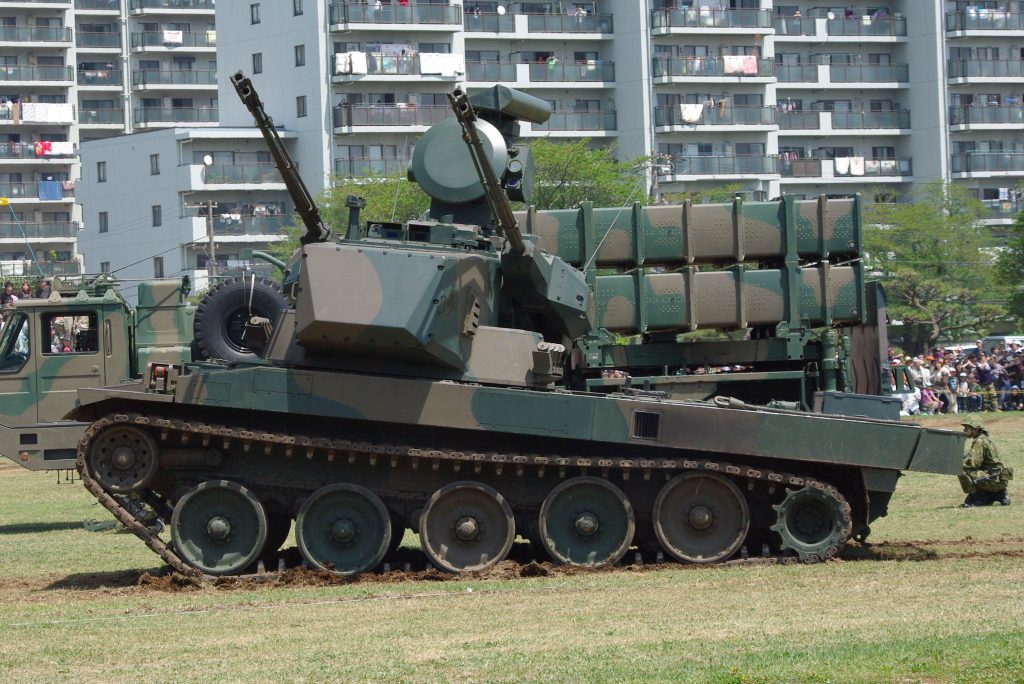
A Type 87 at The Goshisu Garrison displaying its pneumatic suspension. The vehicle in the background is a Type 03 Medium-Range Surface-to-Air missile system
Vulnerability
While the Oerlikon weapon system is a superb piece of ballistic engineering, it cannot match the range of aircraft or helicopter-borne Air-to-Ground missiles. As such, the Type 87 is vulnerable from being out ranged by the very aircraft it is attempting to destroy.
The vehicle is armored, however, with the forward hull protected by a 33 mm of armor, supported by composite plates. The Type 87 is also equipped with NERA (Non-Explosive Reactive-Armor).
Service
The Type 87 entered service in, of course, 1987. The vehicles were produced by Mitsubishi up until 2002, with only a meager 52 machines completed to a cost of 1.5 Billion Yen (~13.25 million US Dollars) each.
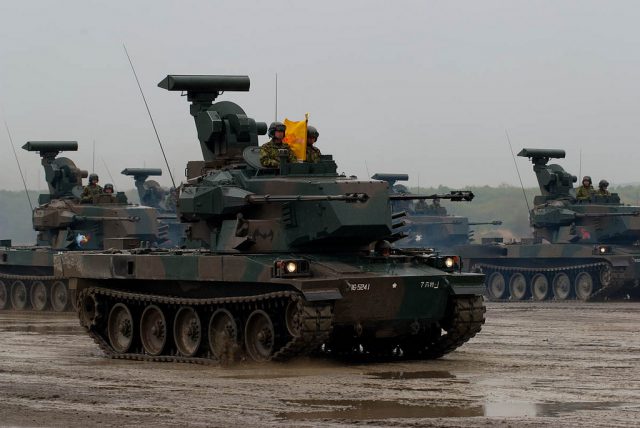
Type 87s taking part in maneuvers.
These vehicles remain in service today and are deployed with units including the anti-aircraft instructor corps of the Ground Self-Defense Force anti-aircraft school, and the Second and Seventh Divisions of the Northern Territory Corp. In combat operations, it would work in conjunction with the Type 03 Medium-Range Surface-to-Air Missile system.
The vehicles often take part in public exercises. It is often nicknamed “Guntank” by the military, given its resemblance to a mech in the Mobile Suit Gundam Anime.
Type 87 during a demonstration at the 2014 Firepower in Fuji event.
Type 87 SPAAG specifications |
|
| Dimensions (L-W-H) Radio erected |
20′ x 10′ 6” x 13′ 5” x 7’5” (6.7 x 3.2 x 4.10 m) |
| Total weight | 44 tons |
| Crew | 3 (driver, gunner, commander,) |
| Propulsion | Mitsubishi 10ZF Type 22, 10-cylinder air-cooled diesel engine, 750 hp |
| Speed (road) | 33 mph (53 km/h) |
| Armament | 2x 35mm Oerlikon cannons |
| Produced | 52 |
Links & Resources
Tankograd Publishing, JGSDF: Vehicles of the Modern Japanese Army, Koji Miyake & Gordon Arthur
The JGSDF Website
The JGSDF Equipment index
Diagram of the Type 87
SENSHA, The Japanese Tank Manual

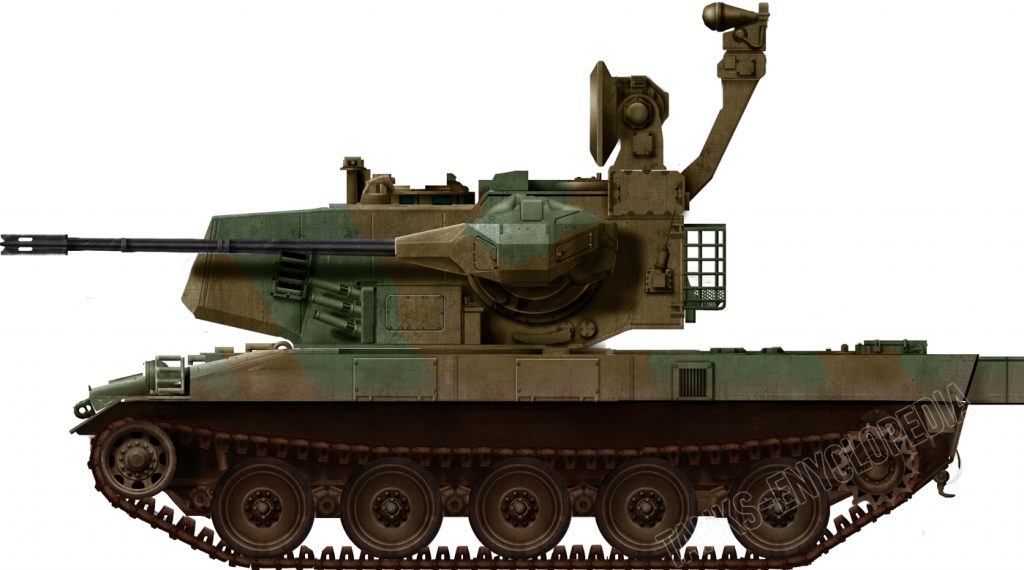
11 replies on “Type 87 SPAAG”
“While the Oerlikon weapon system is a superb piece of ballistic engineering, it cannot match the range of aircraft or helicopter-borne Air-to-Ground missiles. As such, the Type 97 is vulnerable from being out ranged by the very aircraft it is attempting to destroy.”
I think you mean Type 87.
But why would you need pneumatic suspension on a SPAAG?
WHY DONT YOU REPLY???
You don´t need a hydropneumatic suspension on a SPAAG.
But when you take the hull of a MBT 74, so your SPAAG ist as fast and capable and has many common parts, why develop another suspension for it and therefore giving up parts commonality?
I tryed looking into the Type 61 with M51 Skysweeper but found nothing on it. Do you guys have any information on this vehicle?
I’ll ask the team, but there’s probably not much on it out there.
Thank you. Let me know if you find anything solid on it.
Did you have any luck finding anything?
i figure the pneumatic suspension was better for spaag, at this date it probably provided similar performance with fast launches or brakes while also providing a non flammable replacement to hydraulic fluid. also units could still operate if mildly damages, where as if a hydro line was shot and leaking…
Is this SPAAG still in service?
what type of ammo did this AA have because i play warthunder and it has apds and h-vap is that true for this tank?